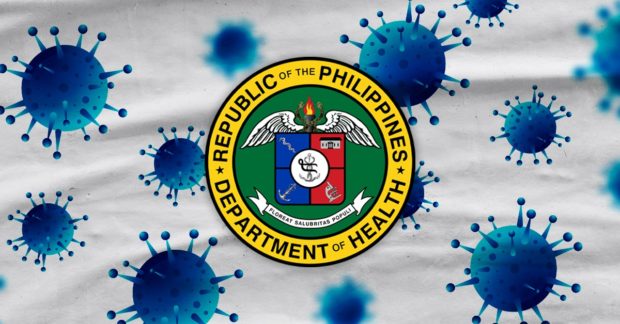Reproduction rate of COVID-19 up in April

Logo of the Department of Health over a graphic representation of the SARS-COV 2, which causes coronavirus disease
MANILA, Philippines — The country’s reproduction rate of COVID-19 slightly rose to 1.03 in the past month, which means that a confirmed case may now infect one other individual, according to the Department of Health (DOH).
The reproduction rate of the coronavirus increased to 1.03 in April 22 from just 0.82 at the start of March.
The reproduction rate gauges the capacity of the virus to spread. Last month’s 0.82 reproduction rate means that a person infected with COVID-19 is capable of transmitting the virus to fewer than one other person.
But the health department on Friday said that this “incremental increase” in the reproduction rate was “small and not sustained.” It added that it was just one of the metrics used to monitor and assess the COVID-19 situation in the country.
Other metrics used by the government and research firms are growth rate, positivity rate, bed and intensive care unit utilization rate, and the average daily attack rate (Adar), which is the average number of new cases per 100,000 population.
Article continues after this advertisement“The [DOH] assures the public that it is continuously monitoring case trends nationwide,” the agency said in a statement.
Article continues after this advertisementIt added that, “such changes have not led to any sustained increases in admissions. Severe and critical contributions to admissions have likewise remained constant.”
Active cases fall below 10K
Health Undersecretary Maria Rosario Vergeire had said that the health-care utilization rates nationwide remained at manageable levels.
The latest data from OCTA Research from April 21 to April 27 showed that the reproduction rate of COVID-19 cases in Metro Manila went up slightly to 0.71, raising the region’s classification to “low” from “very low.”
But the rest of the metrics slid, including the seven-day average of new infections, which decreased to 77 during the same period from 93 in the previous week. The Adar decreased to 0.54 from 0.66.
Active cases nationwide dropped below 10,000 for the first time on Thursday since the surge caused by the Omicron variant hit the country in January, according to the data from DOH’s COVID-19 tracker.
There were a total of 9,585 registered active cases on April 28, exactly four months after the country had active cases below five digits at 9,750 on Dec. 28.
Still alert level 1 for Metro
Meanwhile, Metro Manila would remain under alert level 1 from May 1 to May 15, according to the government’s pandemic response task force.
The Inter-Agency Task Force for the Management of Emerging Infectious Diseases (IATF) also placed under alert level 1: Abra, Apayao, Kalinga, Mountain Province, Baguio City, Ilocos Norte, Ilocos Sur, La Union, Pangasinan, Dagupan City, Batanes, Cagayan, Isabela, Quirino, Santiago City, Aurora, Bataan, Bulacan, Nueva Ecija, Pampanga, Tarlac, Zambales, Angeles City, Olongapo City, Batangas, Cavite, Laguna, Rizal, Lucena City, Marinduque, Oriental Mindoro, Romblon, Puerto Princesa City, Albay, Catanduanes, Naga City.
Also placed under the most lenient pandemic alert classification were Aklan, Capiz, Guimaras, Iloilo Province, Bacolod City, Iloilo City, Siquijor, Cebu City, Lapu-Lapu City, Mandaue City, Biliran, Eastern Samar, Southern Leyte, Ormoc City, Tacloban City, Zamboanga City, Camiguin, Bukidnon, Misamis Oriental, Cagayan de Oro City, Iligan City, Davao City, Surigao del Sur, and Butuan City.
The IATF also placed under alert level 1: Tublay, Benguet, Candelaria, Dolores and San Antonio in Quezon; Cagayancillo, Palawan; Caramoan, Pili, and Tigaon, Camarines Sur; Capalonga, Camarines Norte; Candoni, Negros Occidental and Tobias Fornier (Dao), Antique; Amlan (Ayuquitan), Negros Oriental and Duero, Bohol; and Matalom, Leyte.
In Mindanao, placed under alert level 1 were Jose Dalman (Ponot) and Labason, Zamboanga del Norte; Molave and Ramon Magsaysay (Liargo) Zamboanga del Sur; Buug, Zamboanga Sibugay; Tudela, Misamis Occidental; Baroy, Lala and Tubod in Lanao del Norte; Caraga, Davao Oriental; Koronadal City and Arakan in North Cotabato; Lebak, Sultan Kudarat; Kitcharao, Agusan del Norte; Santa Josefa, Agusan del Sur; Libjo (Albor), Dinagat Islands; General Luna, Surigao del Norte; South Upi, Maguindanao and Turtle Islands, Tawi-Tawi.
RELATED STORY:
OCTA warns new COVID cases may hit 5,000-10,000 daily